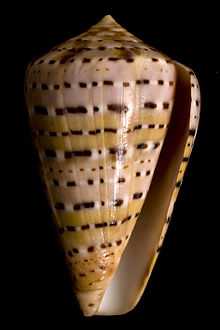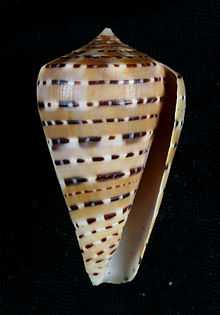Conus genuanus
| Conus genuanus | |
|---|---|
 | |
| Apertural view of a shell of Conus genuanus | |
| Conservation status | |
| Scientific classification | |
| Kingdom: | Animalia |
| Phylum: | Mollusca |
| Class: | Gastropoda |
| (unranked): | clade Caenogastropoda clade Hypsogastropoda clade Neogastropoda |
| Superfamily: | Conoidea |
| Family: | Conidae |
| Subfamily: | Coninae |
| Genus: | Conus |
| Species: | C. genuanus |
| Binomial name | |
| Conus genuanus Linnaeus, 1758[1] | |
| Synonyms[2] | |
| |
Conus genuanus, also known as Genuanoconus genuanus, common name the garter cone, is a species of sea snail, a marine gastropod mollusk in the family Conidae, the cone snails and their allies.[2]
Like all species within the genus Conus, these snails are predatory and venomous. They are capable of "stinging" humans, therefore live ones should be handled carefully or not at all.
Description
The size of an adult shell varies between 33 mm and 75 mm. The ground color of the shell is pink-brown or violaceous brown, with revolving narrow lines of alternate white and chocolate quadrangular spots and dashes. These lines are usually alternately larger and smaller. The surface of the shell is usually smooth, but sometimes the lines are slightly elevated. The spire is smooth.[3]
Distribution
This species occurs in the Atlantic Ocean from the Canary Islands and Cape Verde to Angola; in the Indian Ocean along Madagascar.
References
- ↑ Linnaeus, C., 1758. Systema Naturae per Regna Tria Naturae, 10th ed., 1
- ↑ 2.0 2.1 Conus genuanus Linnaeus, 1758. Retrieved through: World Register of Marine Species on 24 July 2011.
- ↑ George Washington Tryon, Manual of Conchology vol. VI, p. 15; 1879
- Bernard, P.A. (Ed.) (1984). Coquillages du Gabon [Shells of Gabon]. Pierre A. Bernard: Libreville, Gabon. 140, 75 plates pp.
- Pin, M.; Tack, K.D.L. (1995). Les cônes du Sénégal. [The Conidae of Senegal]. La Conchiglia 277(Suppl.): 1-55,
- Gofas, S.; Afonso, J.P.; Brandào, M. (Ed.). (S.a.). Conchas e Moluscos de Angola = Coquillages et Mollusques d'Angola. [Shells and molluscs of Angola]. Universidade Agostinho / Elf Aquitaine Angola: Angola. 140 pp.
- Filmer R.M. (2001). A Catalogue of Nomenclature and Taxonomy in the Living Conidae 1758 - 1998. Backhuys Publishers, Leiden. 388pp.
- Rolán E., 2005. Malacological Fauna From The Cape Verde Archipelago. Part 1, Polyplacophora and Gastropoda
- Tucker J.K. & Tenorio M.J. (2009) Systematic classification of Recent and fossil conoidean gastropods. Hackenheim: Conchbooks. 296 pp
External links
- The Conus Biodiversity website
- Gastropods.com: Genuanoconus genuanus; accessed: 24 July 2011
- Cone Shells - Knights of the Sea
Gallery
-

Conus genuanus Linnaeus, C., 1758
-

Conus genuanus Linnaeus, C., 1758
-

Conus genuanus Linnaeus, C., 1758
-

Conus genuanus Linnaeus, C., 1758
| Wikimedia Commons has media related to Conus genuanus. |

